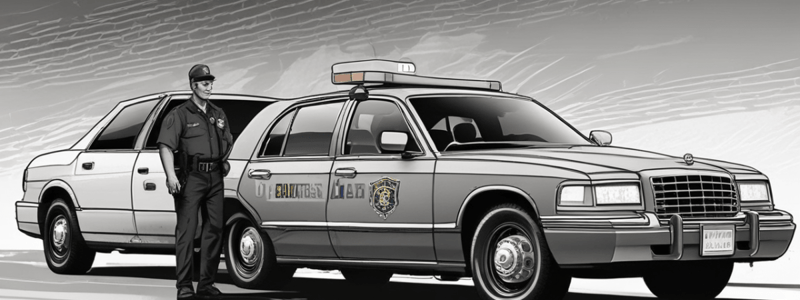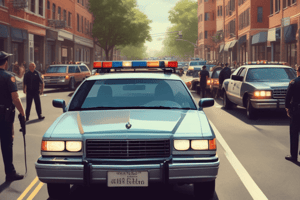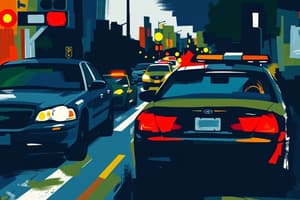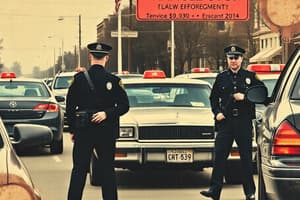Podcast
Questions and Answers
What is the primary focus of the lesson plan?
What is the primary focus of the lesson plan?
- Lecture on felony stops and vehicle positioning
- Vehicle pursuits and foot chases
- Racial profiling and traffic stops
- The proper methods for stopping and approaching vehicles (correct)
What is the objective of identifying the legal justification required to stop a vehicle?
What is the objective of identifying the legal justification required to stop a vehicle?
- To provide evidence for a traffic violation
- To ensure officer safety
- To determine the best location for the stop
- To comply with legal requirements (correct)
What is the primary consideration for selecting the best location for a traffic stop?
What is the primary consideration for selecting the best location for a traffic stop?
- Traffic volume and road conditions (correct)
- Proximity to the police station
- Officer safety
- Availability of backup units
What information should the officer provide to the dispatcher before getting out of the police car?
What information should the officer provide to the dispatcher before getting out of the police car?
What is the first step to take charge of a high-risk stop?
What is the first step to take charge of a high-risk stop?
What should you do if a weapon is visible on a suspect?
What should you do if a weapon is visible on a suspect?
What is the primary objective of positioning the police car during unknown- and high-risk stops?
What is the primary objective of positioning the police car during unknown- and high-risk stops?
What is the purpose of offsetting your vehicle 3-4 feet to allow a sheltered approach lane?
What is the purpose of offsetting your vehicle 3-4 feet to allow a sheltered approach lane?
What is the primary action the officer should take when approaching the traffic violator's vehicle during unknown risk stops?
What is the primary action the officer should take when approaching the traffic violator's vehicle during unknown risk stops?
Why should you avoid stopping on a hill or curve?
Why should you avoid stopping on a hill or curve?
What is the primary objective of removing vehicle occupants during high-risk stops?
What is the primary objective of removing vehicle occupants during high-risk stops?
What is the legal requirement related to racial profiling and traffic stops?
What is the legal requirement related to racial profiling and traffic stops?
What should the passenger officer do in a 2-man car during an unknown risk stop?
What should the passenger officer do in a 2-man car during an unknown risk stop?
Why should you choose a well-lit area for a high-risk stop?
Why should you choose a well-lit area for a high-risk stop?
What is the purpose of positioning your patrol vehicle 30-50 feet behind the suspect's vehicle?
What is the purpose of positioning your patrol vehicle 30-50 feet behind the suspect's vehicle?
What should you do with the suspect after they exit the vehicle?
What should you do with the suspect after they exit the vehicle?
Why should you avoid stopping in a congested area?
Why should you avoid stopping in a congested area?
What should you do before exiting your vehicle during an unknown risk stop?
What should you do before exiting your vehicle during an unknown risk stop?
What is the legal justification required to stop a vehicle?
What is the legal justification required to stop a vehicle?
What should an officer avoid when selecting a location for a traffic stop?
What should an officer avoid when selecting a location for a traffic stop?
What information should an officer provide to the dispatcher before getting out of the police car?
What information should an officer provide to the dispatcher before getting out of the police car?
How should an officer position their patrol car during an unknown risk stop?
How should an officer position their patrol car during an unknown risk stop?
What should an officer do before exiting their patrol car during a traffic stop?
What should an officer do before exiting their patrol car during a traffic stop?
What should an officer do when approaching the suspect vehicle during a traffic stop?
What should an officer do when approaching the suspect vehicle during a traffic stop?
What should an assisting officer do during an unknown risk stop?
What should an assisting officer do during an unknown risk stop?
What should an assisting officer do during a high-risk stop?
What should an assisting officer do during a high-risk stop?
When should an officer remove occupants from a vehicle?
When should an officer remove occupants from a vehicle?
What should an officer do when removing occupants from a vehicle during a high-risk stop?
What should an officer do when removing occupants from a vehicle during a high-risk stop?
What information must a peace officer report to their employing agency after stopping a driver for a motor vehicle violation?
What information must a peace officer report to their employing agency after stopping a driver for a motor vehicle violation?
What is the purpose of the statute RSMo 590.650 and 590.653?
What is the purpose of the statute RSMo 590.650 and 590.653?
What term is used to describe the minimum amount of justification needed to perform a 'Terry Stop'?
What term is used to describe the minimum amount of justification needed to perform a 'Terry Stop'?
What is the primary purpose of articulating reasons for a stop?
What is the primary purpose of articulating reasons for a stop?
What is the main risk if a driver or passenger moves out of their vehicle during a traffic stop?
What is the main risk if a driver or passenger moves out of their vehicle during a traffic stop?
What is the significance of the Whren case in the context of traffic stops?
What is the significance of the Whren case in the context of traffic stops?
What is the primary role of the Command Officer during a high-risk stop?
What is the primary role of the Command Officer during a high-risk stop?
Why was the statute RSMo 590.650 and 590.653 passed?
Why was the statute RSMo 590.650 and 590.653 passed?
What is the purpose of having the driver place their hands behind their head and interlace their fingers?
What is the purpose of having the driver place their hands behind their head and interlace their fingers?
What is the purpose of reviewing objectives and clarifying questions at the end of the lesson?
What is the purpose of reviewing objectives and clarifying questions at the end of the lesson?
What is the officer's primary concern when removing occupants from a vehicle during a high-risk stop?
What is the officer's primary concern when removing occupants from a vehicle during a high-risk stop?
What is the minimum amount of justification required to perform a 'Terry Stop'?
What is the minimum amount of justification required to perform a 'Terry Stop'?
What is the term used to describe a stop where the officer has reasonable suspicion that a crime was, is being, or is about to be committed?
What is the term used to describe a stop where the officer has reasonable suspicion that a crime was, is being, or is about to be committed?
Why is it important for the officer to maintain a safe distance from the felony vehicle?
Why is it important for the officer to maintain a safe distance from the felony vehicle?
What is the significance of the date 12-07-2000 in the context of RSMo 590.650 and 590.653?
What is the significance of the date 12-07-2000 in the context of RSMo 590.650 and 590.653?
What is the purpose of the officer's command 'Driver, with your left-hand reach outside the car and open your door. Then, push the door open with your left foot.'?
What is the purpose of the officer's command 'Driver, with your left-hand reach outside the car and open your door. Then, push the door open with your left foot.'?
What is the officer's primary focus when approaching a felony vehicle during a high-risk stop?
What is the officer's primary focus when approaching a felony vehicle during a high-risk stop?
Why is it important for the officer to be cautious when the driver turns around during a high-risk stop?
Why is it important for the officer to be cautious when the driver turns around during a high-risk stop?
What is the purpose of the officer's command 'Driver, take 2 steps to your left and kick the door shut with your right foot.'?
What is the purpose of the officer's command 'Driver, take 2 steps to your left and kick the door shut with your right foot.'?
What is the officer's primary concern during a high-risk stop?
What is the officer's primary concern during a high-risk stop?
What is the purpose of telling the driver to rest their hands on the steering wheel?
What is the purpose of telling the driver to rest their hands on the steering wheel?
What is the term for casually placing a hand on the gun butt while approaching a vehicle?
What is the term for casually placing a hand on the gun butt while approaching a vehicle?
What is the benefit of approaching a vehicle from the left side?
What is the benefit of approaching a vehicle from the left side?
What is the Crisis Zone?
What is the Crisis Zone?
What is the purpose of dividing the area around the vehicle into Threat Zones?
What is the purpose of dividing the area around the vehicle into Threat Zones?
Why is it safer for the officer to approach through the Crisis Zone?
Why is it safer for the officer to approach through the Crisis Zone?
What is the advantage of the officer's position in the Crisis Zone?
What is the advantage of the officer's position in the Crisis Zone?
What is the disadvantage of the Point Reflex Zone?
What is the disadvantage of the Point Reflex Zone?
What is the effect of an offender's high adrenaline surge during an attack?
What is the effect of an offender's high adrenaline surge during an attack?
Why is a left-handed assailant at a disadvantage in the Crisis Zone?
Why is a left-handed assailant at a disadvantage in the Crisis Zone?
What is the proper procedure for a suspect to remove a weapon?
What is the proper procedure for a suspect to remove a weapon?
What is the purpose of taking the suspect to the rear of the patrol vehicle after cuffing?
What is the purpose of taking the suspect to the rear of the patrol vehicle after cuffing?
What is the role of a cover officer during a felony stop?
What is the role of a cover officer during a felony stop?
What is the 'Rule of 1 More'?
What is the 'Rule of 1 More'?
What should the command officer do after the last occupant has been removed from the suspect vehicle?
What should the command officer do after the last occupant has been removed from the suspect vehicle?
Why should no officer make any physical approach to a vehicle stopped in a felony situation until the command officer has issued a 'bluff announcement'?
Why should no officer make any physical approach to a vehicle stopped in a felony situation until the command officer has issued a 'bluff announcement'?
What should the contact officer do after cuffing the suspect?
What should the contact officer do after cuffing the suspect?
What is the primary purpose of having a contact officer and a command officer during a felony stop?
What is the primary purpose of having a contact officer and a command officer during a felony stop?
What should the contact officer do with the suspect after a thorough search?
What should the contact officer do with the suspect after a thorough search?
Flashcards are hidden until you start studying
Study Notes
Vehicle Stops
- The objective of vehicle stops is to ensure safety for both the officer and the violator.
- Factors to consider when making a vehicle stop:
- Location of the stop (avoid hills, curves, intersections, and traffic lanes)
- Vehicle positioning (offset 3-4 feet to allow a sheltered approach lane)
- Officer's approach (notify dispatcher, park 15-20 feet behind the violator's vehicle, and angle the car at 45 degrees)
High-Risk Vehicle Stops
- Types of high-risk stops:
- Felony stops (verified)
- Wanted person stops
- Suspected felony stops
- Tactics for high-risk stops:
- Choose a location that allows for a safe and controlled approach
- Position the patrol vehicle 30-50 feet behind the felony vehicle
- Use cover and concealment to minimize risk
- Use a loud and clear voice to issue commands to the occupants
Removing Vehicle Occupants
- Roles of officers:
- Command officer: issues commands and provides cover
- Contact officer: removes the occupants from the vehicle
- Cover officers: provide backup and surveillance
- Procedure for removing occupants:
- Command officer issues commands to the occupants
- Occupants are instructed to place their hands behind their head and interlace their fingers
- Driver is instructed to remove the keys from the ignition and place them on the roof of the car
- Driver is instructed to open the door and step out of the car
- Driver is instructed to take 2 steps to the left and kick the door shut
- Driver is instructed to turn slowly around 360° and stop
- Contact officer approaches the driver and takes them into custody
- Contact officer searches the driver and places them in a lockup car
Threat Zones
-
The Crisis Zone: a 20-inch wide strip starting from the violator's rear bumper and ending 10 inches away from the driver's window
-
The Reach Zones: extending forward an arm's length or so from the Crisis Zone
-
The Point Reflex Zone: fanning out from the back corner of the driver's window at a 45° angle
-
The Target Zone: arcing from the Point Reflex Zone around to the front fender of the vehicle
-
Officers should avoid standing in the Point Reflex or Target Zones to minimize risk### Felony Stop Procedures
-
The "Rule of 1 More" suggests that officers should always consider the possibility of one more suspect hiding inside a vehicle.
-
The roles of the command, contact, and cover officers are repeated for each occupant of the suspect vehicle.
-
The command officer instructs the passengers to exit the vehicle, using specific commands to ensure safety:
- "Passenger in the front seat, slide over to the driver's seat with your hands interlaced behind your head."
- "Passenger, reach outside the window with your left hand and open the door. Push it open with your left foot."
- "Step out, hands interlaced behind your head, facing away from me."
-
After the last occupant exits the vehicle, the command officer issues a "bluff announcement" to any possible hidden suspects.
-
The contact officer speed-cuffs each occupant in the kneeling position, thoroughly searches each suspect, and secures each suspect in a lock-up car using the seat belt.
-
Cover officers watch all suspects closely for any signs of aggression.
Felony Stop Considerations
- Felony stops should always be considered dangerous.
- These tactics are recommended to minimize danger and risk to officers.
- No tactic is guaranteed to be 100% successful, and officers should be prepared to use alternative tactics if necessary.
Legal Requirements for Traffic Offense Vehicle Stops
- According to RSMo 590.650 and 590.653, peace officers must report specific information to their law enforcement agency for each traffic stop:
- Age, gender, and race or minority group of the individual stopped
- Traffic violation or violations alleged to have been committed
- Whether a search was conducted and the circumstances surrounding it
- Whether any contraband was discovered and the type of contraband
- Whether any warning or citation was issued and the violation charged
- Whether an arrest was made and the crime charged
- Location of the stop
Racial Profiling
- The "racial profiling" statute (RSMo 590.650 and 590.653) was passed to prevent minorities from being stopped by peace officers because of their minority status.
- The statute does not prohibit vehicle stops based on reasonable suspicion that a crime was, is being, or is about to be committed, and the suspect is involved.
- "Reasonable Suspicion" is also known as "Articulable Suspicion," requiring the officer to articulate their suspicions and be able to put them into words.
Studying That Suits You
Use AI to generate personalized quizzes and flashcards to suit your learning preferences.




